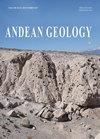The April 2015 Calbuco eruption pyroclastic density currents: deposition, impacts on woody vegetation, and cooling on the northern flank of the cone
IF 0.9
4区 地球科学
Q1 Earth and Planetary Sciences
引用次数: 0
Abstract
The 22-23 April 2015 eruption of the Calbuco volcano (Southern Andes, Chile) led to extensive pyroclastic density currents (PDCs) interactions with vegetation. We seek to describe the PDCs which affected both Tepu and Frío rivers, northern Calbuco, from their timing and deposition to cooling and erosion, as well as their impacts on forests. Our investigation is based on field stratigraphy, forest disturbance assessment, and geothermometry from degassing pipes and charcoal. These PDCs reached at least ~540-603 °C, as estimated from fumaroles, and consisted of both concentrated and dilute PDCs during the first pulse (22 April) at Tepu and mainly during the second pulse (23 April) at Frío. Effects of PDCs on forest vegetation recorded in Tepu consisted of heating, abrasion, burial, and impact force. On the valley floor, trees were buried with up to 4 m of deposits from the concentrated PDCs, and all trees in this deposition zone died with no subsequent sprouting. Conversely, in the margins of the valley, defoliated fallen trees and standing shrubs indicate scorching due to the passage of dilute PDCs, and some of them were later sprouting. Estimated impact forces required to produce toppling range from 1.5 to 3.7 kPa, and PDC velocities reached up to 36 m s-1. Charring of the buried wood involved an emplacement temperature of 400-550 °C within PDC deposits. The rapid watershed formation may have facilitated infiltration, decreasing the temperature in the basal part within the deposits at the Tepu river. Runoff during the subsequent months triggered lahars and caused the rivers to incise the deposits and transport sediment downstream. This set of observations provides valuable insights into how the interaction between volcanic phenomena and margine forest on the valley floors informs eruptive processes, dynamics, and impacts. Our study is also relevant to interpret the thermal history and potential hazards of PDCs.2015年4月Calbuco火山喷发的火山碎屑密度流:沉积,对木本植被的影响,以及锥体北侧的冷却
2015年4月22日至23日,Calbuco火山(智利南安第斯山脉)爆发,导致火山碎屑密度流(PDCs)与植被广泛相互作用。我们试图描述影响卡尔布科北部特普河和Frío河的PDCs,从它们的时间和沉积到冷却和侵蚀,以及它们对森林的影响。我们的调查是基于野外地层学、森林干扰评估和脱气管道和木炭的地热测量。根据火山喷发孔估计,这些PDCs至少达到~540-603°C,在特普的第一次脉冲(4月22日)和Frío的第二次脉冲(4月23日)期间,这些PDCs由浓缩和稀释的PDCs组成。对特普森林植被的影响包括加热、磨损、掩埋和冲击力。在谷底,树木被集中的PDCs沉积物掩埋了高达4米,该沉积带的所有树木都死亡了,没有随后发芽。相反,在山谷边缘,落叶倒下的树木和直立的灌木表明由于稀释的PDCs通过而烧焦,其中一些后来发芽。产生倾覆所需的估计冲击力范围为1.5 ~ 3.7 kPa, PDC速度可达36m s-1。埋藏木材的炭化涉及PDC沉积物中400-550°C的就位温度。快速的流域形成可能促进了入渗,降低了特浦江沉积物基底部分的温度。随后几个月的径流引发了火山泥流,导致河流切割沉积物并将沉积物输送到下游。这组观测结果为火山现象和山谷底部边缘森林之间的相互作用如何影响喷发过程、动力学和影响提供了有价值的见解。我们的研究也与解释PDCs的热历史和潜在危害有关。
本文章由计算机程序翻译,如有差异,请以英文原文为准。
求助全文
约1分钟内获得全文
求助全文
来源期刊

Andean Geology
地学-地质学
CiteScore
2.60
自引率
0.00%
发文量
17
审稿时长
>12 weeks
期刊介绍:
This journal publishes original and review articles on geology and related sciences, in Spanish or English, in three issues a year (January, May and September). Articles or notes on major topics of broad interest in Earth Sciences dealing with the geology of South and Central America and Antarctica, and particularly of the Andes, are welcomed.
The journal is interested in publishing thematic sets of papers and accepts articles dealing with systematic Paleontology only if their main focus is the chronostratigraphical, paleoecological and/or paleogeographical importance of the taxa described therein.
 求助内容:
求助内容: 应助结果提醒方式:
应助结果提醒方式:


